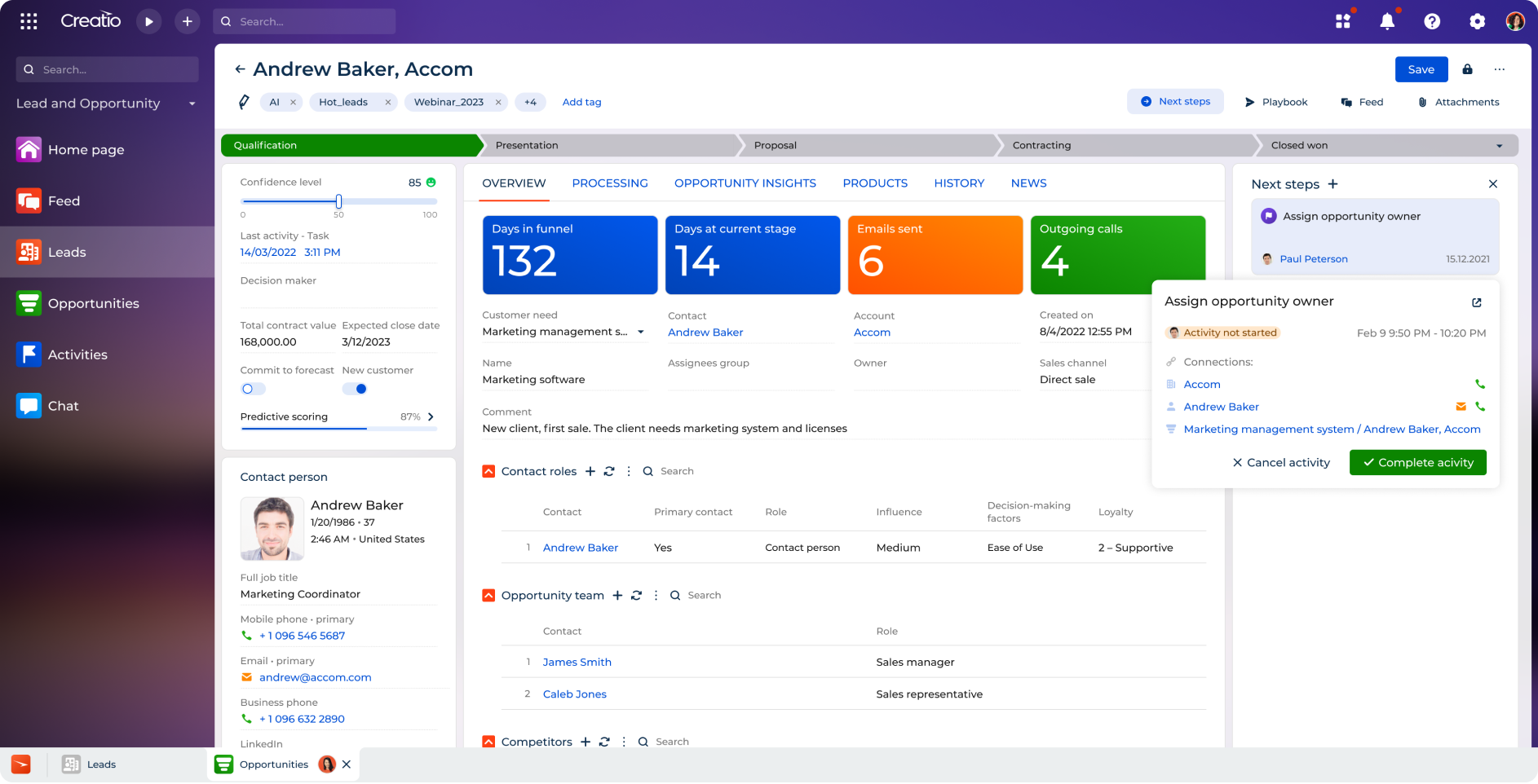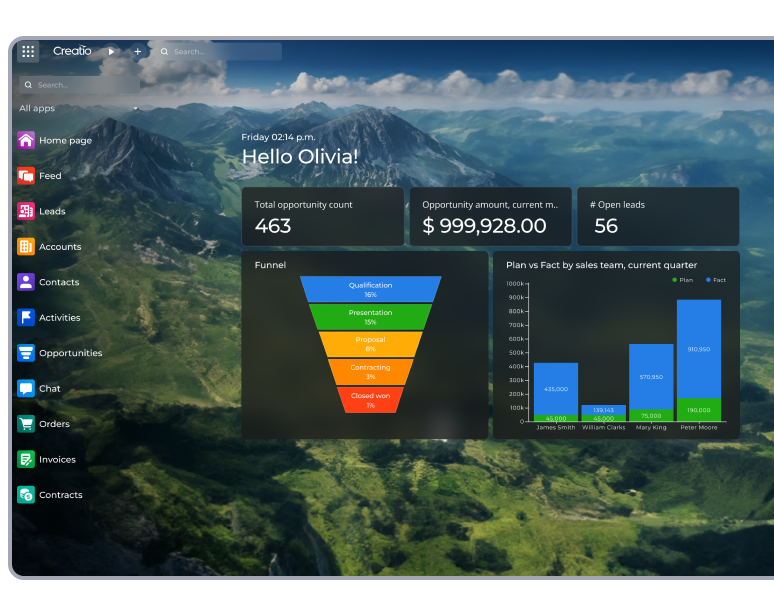-
No-Code
Platform
-
Studio
No-code agentic platform delivering the fastest time-to-value and the highest ROI
-
Studio
-
AI-Native CRM
CRM
-
AI-Native CRM
New era CRM to manage customer & operational workflows
CRM Products -
AI-Native CRM
- Industries
- Customers
- Partners
- About
Creatio: One Platform to Track and Win Opportunities

Imagine Jane, a sales manager, peering into her team's sales pipeline. Each entry represents a potential sales success story. Yet, the question that bugs Jane remains: how would I turn these prospects into conversion and actual profits?
Jane understands that in sales, each of her opportunities is a precise balance of risk and reward. She often wonders, "How can I guide these opportunities to a fruitful conclusion? What is it that distinguishes a missed chance from a winning deal?"
Enter management of sales opportunities as your key to sales success. Is it all about obtaining new leads? Not really. The process is about carefully identify sales opportunities and nurturing the leads.
Each of your prospect’s journeys toward becoming a profitable customer involves continuous efforts and critical decision-making. You and your sales team must recognize that the real challenge starts once the leads are in the pipeline.
Using sales opportunity management, you would understand each prospect's specific needs and develop customized support at each step of their purchasing journey. But what goes into creating a successful opportunity management strategy? What tools and methods can turn potential into tangible outcomes? How can you leverage opportunity management tool or software?
We will explore these vital questions today as we go deep into the fundamentals of opportunity management in sales.
What is Opportunity Management in Sales?
Opportunity management in sales is a strategic approach that lets you organize and track potential deals within a sales pipeline. Each of your leads has its own unique story and promise. The approach allows you to identify and prioritize deals with the highest likelihood of successful closure. Here's a simplified breakdown:
- Identifying the right opportunities: Imagine handpicking guests for a special event. Which deals in your sales pipeline are the 'VIPs' – the ones most likely to close? Managing opportunities and prospects is about recognizing them.
- Understanding each prospect: As you would cater to the unique tastes of your party guests, in sales, it’s about understanding the specifics of each prospect. What do they like and prefer? What might be their reservations? How can you tailor your sales approach to make a perfect match?
- Keeping the engagement alive: In sales, maintaining interest is crucial. What strategies can you employ to ensure that your prospects stay engaged and continue progressing towards a purchase? Knowing the answers will help you seal successful deals.
- Making data-driven decisions: Think about using feedback from previous events to enhance the next one. Similarly, in sales, you can leverage data from every interaction to refine your approach. What insights can you gather from this data to improve your sales tactics?
- Refining sales strategies: Finally, how do you use all this information to achieve your sales targets? Constant adjustments to your strategies will help you focus on the opportunities with the highest likelihood of conversion.
Managing your sales opportunities, therefore, is about asking the right questions and using the insights gained to direct your sales efforts.
Opportunity Management and Lead Management
Before we get into exploring how to manage opportunities in detail, we must not confuse them with lead management. So, what is lead management? How does it differ from the opportunity management flow? The understanding starts with the basic building blocks: what exactly are leads and opportunities?
What is a lead?
A lead is essentially the potential customer who has indicated the first sign of interest in your product. This is at a very early stage, and the individual is not yet qualified for further sales engagement.
- The starting point: Imagine someone walking into a store, browsing but not yet buying. For your sales department, this is a lead – a potential customer showing initial interest.
- Where they come from: Leads often spring from various marketing efforts. Email campaigns, social media interactions, or website visits are among the examples. Imagine casting a wide net, hoping to catch some fish.
- Gathering and sorting the basic details: Leads typically provide surface-level information: name, contact details, and maybe a hint about their interests or budget. But are they ready to buy? That's still a question mark.
What is an opportunity?
An opportunity is the progression of a lead into a potential sale. The transition signifies a higher level of interest and engagement from the customer. Opportunities represent a deeper connection. with prospective customers and a real possibility of converting interest into a sale.
- A step further than leads: Think of a shopper returning to the store, asking detailed questions about a product. Good news for the sales rep! Your lead has become an opportunity – a lead that’s shown more than a passing interest.
- Qualification: An opportunity means the potential customer is not just browsing. Instead, they're seriously considering a purchase. Returning to our previous fishing analogy, it's like a fish circling the bait, closer to being caught.
- Engagement: Here, the game changes. Now is the time when you would provide demos, create customized proposals, and negotiate pricing and service terms. The focus shifts from general interest to specific actions toward a sale.
To summarize, leads are the starting point, the initial spark of interest. Opportunities, on the other hand, are where things get serious. Understanding the customer’s transition from being a lead to becoming an opportunity is critical in sales.
Difference between lead and opportunity management
Both opportunity and lead management belong to the sales cycle. Yet, they have several inherent differences.
- Initial capture vs. advanced nurturing: Lead management focuses on capturing potential prospects through various channels. In contrast, opportunity management is centered on nurturing those leads further into the sales funnel.
- Qualification and segmentation: Lead management emphasizes qualifying leads and segmenting them for targeted communication, whereas opportunity management is about converting these qualified leads into sales.
- Database creation vs. detailed analysis: Creating and sorting a database of contacts is crucial for successful lead management. Opportunity management, on the other hand, requires a deeper analysis of customer data to pinpoint the most promising sales opportunities.
- Resource alignment and proposal creation: Lead management guides leads to the appropriate sales representatives, while opportunity management aligns resources and crafts customized proposals to seal deals.
- Process optimization and customer customization: Opportunity management requires tailoring products and services to customer needs and optimizing communication channels, unlike lead management, which deals more with gauging initial interest.
Both lead and opportunity management are vital in a business's strategy to foster growth and maximize revenue efficiently. They play complementary roles in the overall success of the sales and marketing efforts.
Why Do You Need Sales Opportunity Management?
Why is sales opportunity management crucial for your business? Every sales manager strives to aim for efficiency and effectiveness in sales efforts. Mastering opportunity management leads you down the path. Here's why it's a game-changer:
- Understanding your prospective customer: With opportunity management, you gain deep insights into your prospects. This knowledge allows you to tailor your communication and engagement strategies based on the business potential of each prospect.
- Optimizing customer approach: Opportunity management helps you interact with potential customers in the most effective way. You can fully understand their level of interest and the current state of your relationship with them.
- Identifying sales process gaps: Adequately managing your opportunities enables you to pinpoint areas for improvement in your sales process. Consequently, you can constantly enhance how you interact with prospects.
- Increasing conversion rates: By effectively managing sales opportunities, you aim to convert more prospects into customers. The activities ultimately boost your business's revenue.
- Streamlining the sales pipeline: You’ll benefit from a structured process for moving deals efficiently toward closure. It starts right from identifying ideal prospects and continues up to signing the contract.
Opportunity management strategically guides your sales teams from potential deals to successful conclusions, often intersecting with broader marketing strategies and core CMO tasks. By focusing on these key areas, you can elevate your sales process, enhance customer relationships, and improve your business ROI.
Opportunity Management Best Practices
Opportunity management is crucial for sales success and business growth. However, you must not be deceived to think that the process is straightforward. As a sales manager, you must follow a set of best practices for optimal results.
Here are some essential best practices:
- In-depth pipeline analysis: Conduct a thorough examination of your sales pipeline. A company, for example, might analyze each stage to identify where opportunities are getting stalled, allowing for targeted strategies to effectively move these opportunities forward.
- Clear task and role assignments: Specify tasks and responsibilities for each stage of the opportunity. A tech firm, for instance, might have one team member handle initial demonstrations, another for follow-up discussions, and yet another for final negotiations. The structure and workflow process would ensure each step is managed by someone with appropriate and required skills.
- Employing automation tools: Use automation tools to keep track of deadlines and tasks related to opportunities. A retail business could use a CRM system or dedicated opportunity management software to send automatic reminders to sales reps for follow-ups. The practice helps the sales reps avoid missed opportunities.
- Data-driven strategy refinement: Regularly analyze performance metrics such as win rate and average deal size. For example, a marketing agency might review their closed and lost opportunities each quarter to uncover patterns or trends. The managers can then refine their future strategies.
Adopting these best practices can enhance opportunity management processes, leading to more efficient sales strategies and an increased likelihood of closing more deals.
Opportunity Management in Creatio CRM
Creatio’s Sales platform empowers businesses with a comprehensive and effective opportunity management system that maximizes sales potential. It empowers users to employ efficient tactics for each opportunity, from identifying key decision-makers to tracking competitors' strengths and weaknesses. The platform ensures meticulous record-keeping, allowing users to trace the complete history of any opportunity, encompassing activities, emails, quotes, feed discussions, files, and notes.
Designed for corporate sales, Creatio provides pre-configured, industry-recommended processes, offering optimal strategies for prolonged sales cycles. Action-oriented dashboards act as guides, directing users through crucial sequential steps at various pipeline stages. The platform furnishes comprehensive statistics on opportunities, enabling evaluation of sales efficiency at each stage, identifying top-performing sales representatives, and monitoring the overall sales department's effectiveness.
In essence, Creatio's Sales platform encapsulates robust tools tailored for comprehensive opportunity management. By choosing Creatio, you unlock the power of streamlined customer relationship management and automated opportunity management, optimizing your sales strategy for success.
FAQ
What is opportunity management?
Opportunity management is the process in a business's sales strategy that involves tracking, nurturing, and converting leads into paying customers. It focuses on identifying the most promising sales opportunities, guiding them through the sales process, and strategically prioritizing efforts to enhance the chances of successful deal closures.
What are the components of opportunity management?
Components of opportunity management include prospect identification, qualification of potential customers, tailored engagement strategies, development of specific sales tactics, continuous monitoring and analysis of sales progress, effective deal closing, and post-sale customer follow-up. These elements collectively ensure a systematic approach to converting opportunities into successful sales.























































